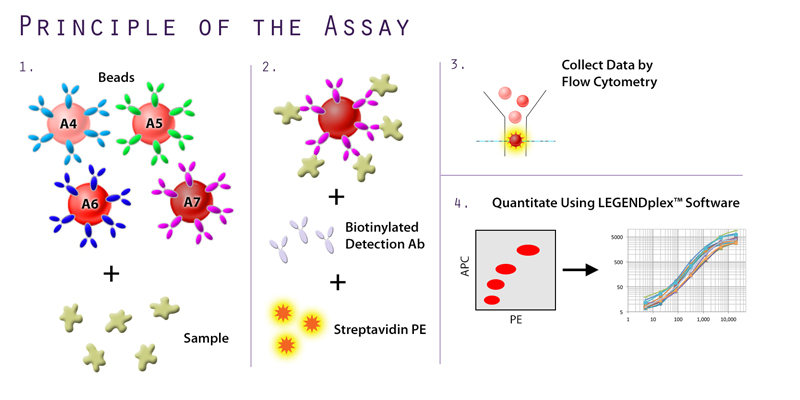Introduction to LEGENDplex™
| Multi-parameter/multi-target analysis within a single sample is becoming the norm in research, be it flow cytometry, microscopy or ELISA. But, these assays can still have their own limitations. For example, ELISAs have a few features that could serve as limiting factors. If the plates are not pre-coated, overnight incubations are recommended. A single scientist can only perform so many ELISAs simultaneously before there are too many plates to handle. ELISAs also typically require relatively high sample volumes (and can double or triple if your samples are run in duplicate or triplicate). Anyone who has managed cell culture supernatants or tried to draw blood/serum samples from mice knows how difficult it can be to get enough sample to cover all of the analytes they want to look at. In addition, if the assay doesn’t go well, that large amount of sample is lost. | ||
| If any of the limitations of ELISA concern you, then you might consider LEGENDplex™. LEGENDplex™ utilizes capture beads, biotinylated detection antibodies, and Streptavidin-PE for analyte detection, making it similar to the principles of the sandwich ELISA. | ||
 |
||
| As mentioned above, LEGENDplex™ is a bead-based assay. Forward and side scatter can separate these beads into two groups. Within a group, the beads themselves have an intrinsic signal that can be read in the FL4 channel (APC) or FL3 if you only have the blue laser on your cytometer. This is what allows you to separate different capture beads from one another. The amount of PE signal (FL2) you observe is directly related to the amount of analyte bound by the capture beads. And, because you run a standard curve alongside your samples, you’ll be able to quantitate the concentration of the analytes. Conveniently, you can use LEGENDplex™ with any flow cytometer capable of reading APC and PE. And, even if you only have the blue laser, all you need is the FL2 and FL3 channels (although compensation will be required with FL1). | ||
 |
||
| This is data from one set of beads. Capture beads can be separated by their intrinsic APC (FL4) signal. As more analyte is bound to the capture bead, more PE-Streptavidin will bind, increasing the signal in FL2. | ||
| With LEGENDplex™, you can analyze up to 13 different cytokines or chemokines. These can be ordered as Pre-defined Panels here, or you can use the Mix and Match system to pick specific analytes from either the cytokine or chemokine categories. Pricing is excellent in the Mix and Match system as the required standards and detection antibodies are each packaged in a single catalog item. In other words, whether you create a 2-plex or a 13-plex, you only need one set of standards and one set of detection antibodies. If you would like to pick both cytokines and chemokines, this would require non-overlapping beads, and customization of the standards and the detection antibody cocktail, so you should contact our custom solutions team for help. | ||
LEGENDplex™ makes your lab life a lot easier and saves you on:
You can learn more about LEGENDplex™ here. If you have any questions about LEGENDplex™, contact us at tech support: techserv@biolegend.com. |
||
| Contributed by Ken Lau, PhD. | ||
 Login/Register
Login/Register 






Follow Us